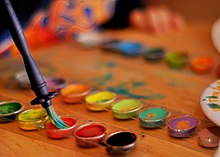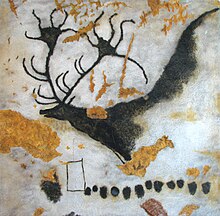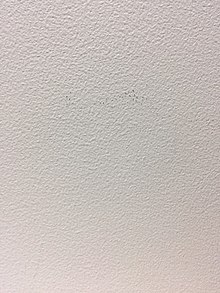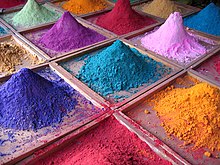Paint (material)
This article deals with the nature of materials, as well as their applications in construction and engineering. The artistic part of painting and its techniques are better described in the article Painting.
Paint is a fluid product that, applied to a surface in relatively thin layers, transforms after a while into a solid layer that adheres to said surface, in such a way that it covers, protects and decorates the element on which it has been applied.
In ancient times, paint was made from pigment.
It is usually applied with implements such as brushes, rollers, guns or directly by immersion.
History
Painting was one of humanity's first arts. Some cave paintings drawn with red or yellow ocher, hematite, manganese oxide, and charcoal may have been made by early Homo sapiens as early as 40,000 years ago. The painting may be even older. In 2003 and 2004, South African archaeologists reported finds in Blombos Cave of a 100,000-year-old man-made ocher-based mixture that could have been used as paint. Further excavations in the same cave resulted in the 2011 report of a complete toolkit for grinding up pigments and making a primitive paint-like substance.
The interior walls of the 5,000-year-old Ness of Brodgar have been found to incorporate individual stones painted in yellows, reds, and oranges, using an ocher hematite pigment mixed with animal fat, milk, or eggs.
The ancient colored walls of Dendera, Egypt, which were exposed to the weather for years, still retain their brilliant color, as vivid as when they were painted some 2,000 years ago. The Egyptians mixed their colors with a gummy substance and applied them separately from each other, without mixing them. It seems that they used six colors: white, black, blue, red, yellow and green. They first covered the entire area with white, and then traced the design in black, leaving out the highlights of the base color. For red they used red lead, generally dark in tone.
The oldest known oil paintings are Buddhist murals created around AD 650. The works are found in cave-like rooms carved into the cliffs of the Bamiyan Valley, Afghanistan, "using walnut and poppy seed oils"." Pliny mentions painted ceilings in his time in the city of Ardea, which had been made before the founding of Rome. He expresses his surprise and admiration for its freshness, after the passage of so many centuries.
In the 13th century, oil was used to detail tempera paintings. In the 14th century, Cennino Cennini described a pictorial technique using tempera paint covered with light layers of oil. The slow drying properties of organic oils were known to early European painters. However, the difficulty in acquiring and working the materials meant that they were little used (and in fact the slow drying was considered a disadvantage). The paint was made with the yolk of eggs and, therefore, the substance hardened and adhered to the surface on which it was applied. The pigment was made with plants, sand and different soils. Most paints used oil or water as the base (the diluent, solvent, or vehicle for the pigment).
The Flemish trained or influenced by Antonello da Messina, to whom Vasari wrongly attributed the introduction of oil painting in Italy, does seem to have improved the formula by adding Litharge, or lead(II) oxide. A still extant example of oil painting in a 17th century lowercase house is Ham House in Surrey, England, where it was used a primer together with several base coats and an elaborate topcoat; the pigment and oil mixture would have been ground into a paste with a mortar and pestle. The painters carried out the process by hand, which exposed them to lead poisoning, due to the white lead dust.
In 1718, Marshall Smith invented a "Machine or motor for grinding colours" in England. It is not known exactly how it worked, but it was a device that increased the efficiency of pigment grinding dramatically. Soon a company called Emerton and Manby was advertising paints at exceptionally low prices that had been ground with labor-saving technology:
A pound of color ground in a horse mill will paint twelve yards of work, while color ground in any other way will not do half that amount. By the middle of the 18th century, with the start of the Industrial Revolution, paint was ground in steam mills and had been found an alternative to lead-based pigments in a white derivative of zinc oxide. Interior painting of houses became the norm as the 19th century progressed, both for decorative reasons and because the paint was effective in preventing damp rot on the walls. Linseed oil was also increasingly used as an inexpensive binder.
In 1866, Sherwin-Williams in the United States opened as a large paint manufacturer and invented a paint that could be used from the can without preparation.
It wasn't until the stimulus of World War II created a shortage of linseed oil in the supply market that artificial resins, or alquitars, were invented. Inexpensive and easy to make, they also held color well and were long lasting.
Types of paint
There are different types of paints, such as varnishes, enamels, lacquers, dyes, toners and sealers, among others; each one with physical and chemical properties that must be taken into account when choosing the right product, either due to the type of surface to be applied, the aesthetic character or the bad weather to which it will be subjected.
The most common are:
Stamina
It is the most widely used type of paint for interior walls. It is a permeable, porous, matte-looking paint. It cannot be washed or placed in areas exposed to rain or water condensation.
Plastic paint
It is a pigment with which you can clean any stains you may receive. It is used in rooms, dining rooms, bedrooms, etc. It should not be used in places where steam is produced, such as bathrooms or kitchens, because since it generates an impermeable layer it does not allow the passage of steam, for this reason it is common for blisters to form on its surface. In these enclosures it is convenient to use paints of different composition and more permeable that allow the passage of gases. It is applied mainly on plaster or cement renders and derivatives.
To apply it on other materials such as metal or wood, a special treatment called primer is necessary, although the durability is not good, and for finishes, it has a certain tendency to leave marks from the tool used for its application. For these substrates there are specific paints known as synthetic enamel.
It is also known as “emulsion paint” or “rubber paint” (mainly in Venezuela). Another characteristic that distinguishes it is the fact that it is soluble in water, which is why it does not require synthetic solvents such as white spirit.
They usually have a matte finish, although a few have a slightly glossy or "satin" finish.
Greasy nail polish
It is used both for the interior and for the exterior, and for walls and ceilings as well as for furniture, doors, windows, metals, etc. It offers resistance to water, loses shine if exposed to the sun, is easily washable, good resistance to rubbing, slow drying, especially at low temperatures, and good extensibility. It is known as "oil paint" and is not soluble in water but in solvents such as white spirit, turpentine, acetone, toluene, etc.
Synthetic enamel
This is the type of paint that best retains its shine, even outdoors. The finish is smooth, with a matt, satin or glossy appearance. It is widely used to protect metal and wooden surfaces, both indoors and outdoors. Unlike oily enamel, it dries faster. Some of them are ultra-fast drying and must be applied exclusively with a spray gun.
By extension it is also called “oil paint” since it does not dissolve in water either but in synthetic solvents such as hexane, acetone, MEK, toluene, xylene, etc.
Cement paint
It has a matt appearance and is relatively resistant to wear and erosion caused by rain, wind, etc. It is used outdoors, on surfaces that must be rough for it to adhere without problems. They are purchased as a powder and mixed with water, it is important to apply it right after mixing with water as they harden quickly. This type of cementitious paint has been widely surpassed in recent years by specific paints for exteriors, among which we can find floor paints, etc. These, more modern, have much greater resistance to atmospheric agents and their finish is much better than cementitious ones. However, those derived from white cement are still being used due to their low cost compared to those mentioned. In tropical and subtropical climates, in case of using cementitious paints, it is necessary to repaint every year after the rainy seasons.
Lime paint
The great advantage of this paint, in addition to its low cost, is that due to its alkalinity it tends to destroy organic matter, therefore it is useful for painting rooms in abandoned houses or those that have not been used for a while where there is the presence of insects. It's antiseptic. It is not suitable for outdoors, because rainwater tends to remove it even if additives commonly called fixatives are added. The carbonation process, that is, the formation of the solid layer, occurs exclusively in the presence of carbon dioxide from the air. It takes time to set on rainy or very humid days. It also has the great additional advantage of allowing vapors to pass through, which is why it is suitable for use in bathrooms and kitchens, since it allows the "breathing" of the facing, thus reducing the possibility of fungal formation (since these are produced in anaerobic environments, that is, without the presence of air). That condition also prevents this type of paint from blistering. In any case, it is a low-quality painting, this is noticeable by its appearance and in particular because when lying down it remains partly adhered to the clothes. There are paints called for ceilings, cheaper than plastic that are specific for bathrooms and kitchens and offer a more pleasant appearance, but do not have the antiseptic property of lime paints. The appearance is matte. It should not be used on plaster, wood or metal. Care must be taken when using this type of paint, as it is corrosive and can burn your hands.
Lacquered
The surface is completely smooth and shiny. It is a very popular type of paint, especially for painting furniture, doors, etc. You have to know how to use this technique well, since there are several layers of different products and adhesion problems can arise between them, if they are not applied correctly. Unlike varnishes, they are used for interiors.
Decorative paintings
For a different look, there are special paints that imitate marble or stucco, or that resemble antique, rustic, or multicolored finishes.
Vinyl
Vinyl is present in acrylic or vinyl paint; It has the same function as oil in oil painting. It is a medium that allows pigment to adhere to surfaces. It is colorless and is soluble in water. It has a shorter drying time than oil paint, and greater resistance to the elements, although its durability against oil paint has not yet been determined. There are 3 manufacturing phases for vinyl paints: premix, grind and completed and quality control. The premix consists of mixing the solid ingredients, part of the resins and solvents to form a viscous paste that already has the final color.
Paint components
All paints are made up of a series of by-products:
- Pigments: they are powder-shaped materials that when they are supplied in the product, they provide color and opacity
- Addlutinants: They are liquids or solids in charge of retaining pigments once the paint has been formed
- Solvents: they are substances responsible for the dissolution of the agglutinant in case it is solid; and fluidify it in case of a liquid aglutinant
- Plastifying: the effect of the plasticizer is to make the material to which it is added to be more malleable, to acquire greater plasticity and therefore to be easier to treat it industrially. His final concentration is usually very low.
- Charges:
These coatings have the following properties to varying degrees, depending on the composition of the coating: good flow and leveling; satisfactory spray rate and film thickness; fast drying, high impermeability, good adhesion, flexibility and hardness, resistance to abrasion and durability.
It also refers in the first place to the substances used to give color and that are usually a mixture of a pigment with a binder that is the substance that adheres to it so that the paint is fixed to the material in which it is going to be applied. work, a liquid is also added to it according to the desired consistency. There are also paints that do not require a binder, such as: pastels, charcoal, graphite, etc. By extension, some works made with said materials are also called this way.
There are many valid techniques for making paintings, as well as supports and motivations. The techniques can be differentiated into fatty and aqueous. The supports in fixed or immovable (parietal or mural) and mobile (easel painting).
Art
Since the Renaissance, siccatative (blotter), primarily linseed oil, has been the most widely used type of paint in fine art applications; oil painting is still common today. However, in the 20th century, new water-based paints such as acrylic paint entered the market with the development of acrylic and other latex paints. Milk (also called casein) paints, in which the medium is derived from the natural emulsion that is milk, were common in the XIX and are still used. Used by early Western artists, egg tempera (in which the medium is an emulsion of raw egg yolk mixed with oil) continues to be used as well, as do encaustic wax-based paints. Gouache is an opaque variant of watercolour, which is based on different levels of translucency; both paints use gum arabic as a support and water as a diluent. Gouache is also known as "designer colour" or "body color".
Poster paint is a distemper paint that has been used primarily in the creation of artwork by students, or by children. There are several brands of sign paint, and depending on the brand, the quality will be different. Cheaper brands tend to crack or fade over time if left on a sign for too long.
Contenido relacionado
Solomon lefschetz
Extreme programming
Race condition






